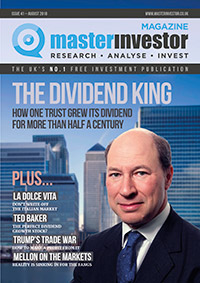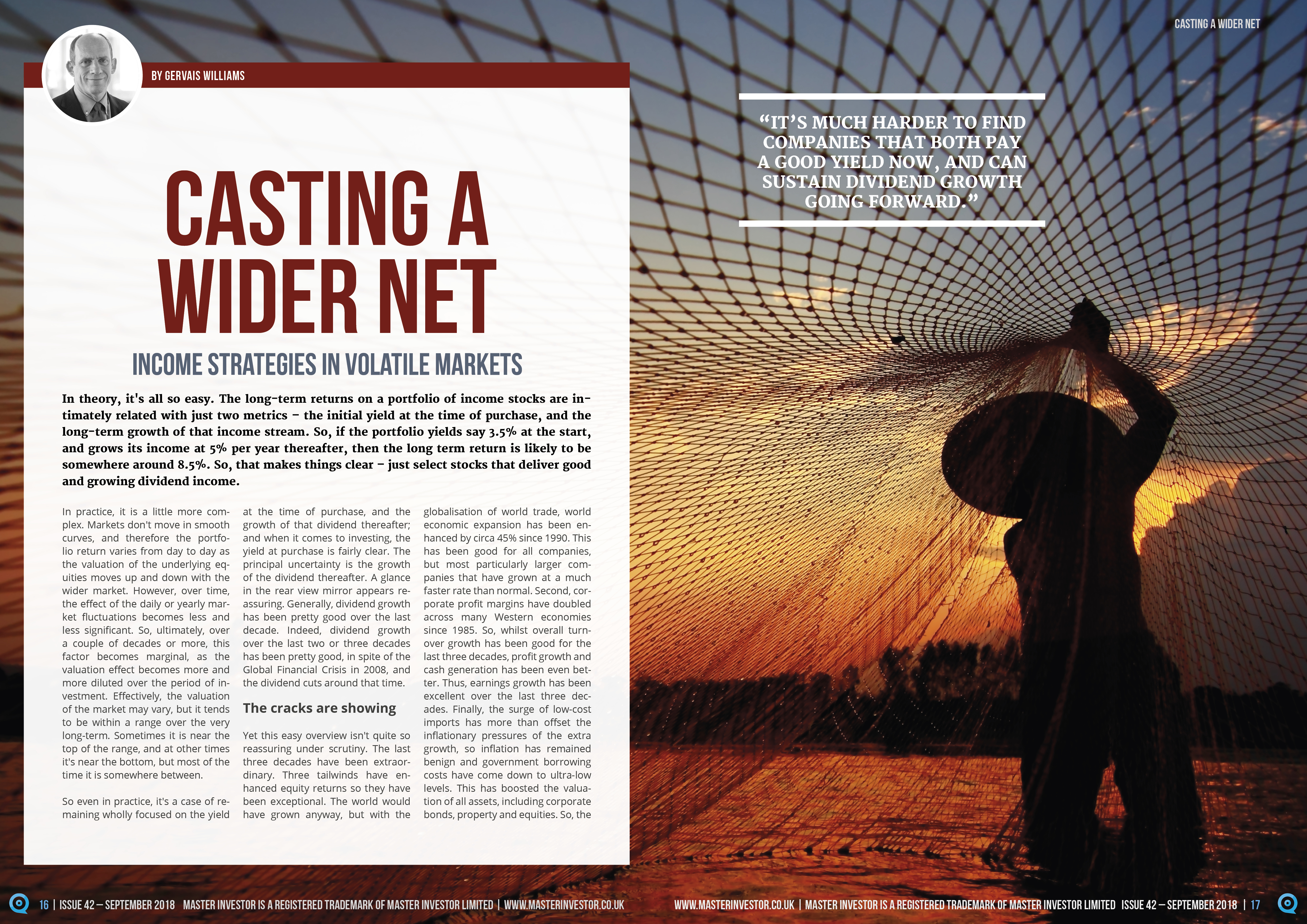Casting a wider net: Income strategies in volatile markets – MAGAZINE EXCLUSIVEMAGAZINE EXCLUSIVE

MAGAZINE ARTICLE
This article first appeared in Issue 41 of Master Investor Magazine.
Click here to download the article as a printer-friendly PDF

Get this article and many more – for free! |
In theory, it’s all so easy. The long-term returns on a portfolio of income stocks are intimately related with just two metrics – the initial yield at the time of purchase, and the long-term growth of that income stream. So, if the portfolio yields say 3.5% at the start, and grows its income at 5% per year thereafter, then the long term return is likely to be somewhere around 8.5%. So, that makes things clear – just select stocks that deliver good and growing dividend income.
In practice, it is a little more complex. Markets don’t move in smooth curves, and therefore the portfolio return varies from day to day as the valuation of the underlying equities moves up and down with the wider market. However, over time, the effect of the daily or yearly market fluctuations becomes less and less significant.
So, ultimately, over a couple of decades or more, this factor becomes marginal, as the valuation effect becomes more and more diluted over the period of investment. Effectively, the valuation of the market may vary, but it tends to be within a range over the very long-term. Sometimes it is near the top of the range, and at other times it’s near the bottom, but most of the time it is somewhere between.
So even in practice, it’s a case of remaining wholly focused on the yield at the time of purchase, and the growth of that dividend thereafter; and when it comes to investing, the yield at purchase is fairly clear. The principal uncertainty is the growth of the dividend thereafter. A glance in the rear view mirror appears reassuring. Generally, dividend growth has been pretty good over the last decade. Indeed, dividend growth over the last two or three decades has been pretty good, in spite of the Global Financial Crisis in 2008, and the dividend cuts around that time.
The cracks are showing
Yet this easy overview isn’t quite so reassuring under scrutiny. The last three decades have been extraordinary. Three tailwinds have enhanced equity returns so they have been exceptional.
The world would have grown anyway, but with the globalisation of world trade, world economic expansion has been enhanced by circa 45% since 1990. This has been good for all companies, but most particularly larger companies that have grown at a much faster rate than normal.
Second, corporate profit margins have doubled across many Western economies since 1985. So, whilst overall turnover growth has been good for the last three decades, profit growth and cash generation has been even better. Thus, earnings growth has been excellent over the last three decades.
Finally, the surge of low-cost imports has more than offset the inflationary pressures of the extra growth, so inflation has remained benign and government borrowing costs have come down to ultra-low levels. This has boosted the valuation of all assets, including corporate bonds, property and equities. So, the valuation of markets is at the top end of the long-term range currently, and therefore it’s much harderto find companies that both pay a good yield now, and can sustain dividend growth going forward.
Note this statement: Whilst everything looks good in the rear-view mirror, there are questions as to whether the historic trends will persist into the future. Specifically, the tail winds of globalisation appear to be coming to an end.
Prior to the Global Financial Crisis, productivity improved, and this tended to boost the growth of corporate cash flow. However, productivity has stagnated over the last decade or so, with the market distortions of Quantitative Easing, and other factors. Therefore, corporate cash flow has not grown as well as previously. This has led the tax take to slow, and governments around the world have been forced into austerity. In addition, the lower growth in cash flow has made it harder for companies to sustain dividend growth. Many have fudged it for now, through bringing dividend cover down to somewhat risky levels.
But perhaps most importantly, the absence of organic cash flow growth has led to disappointing wage growth. Over the last decade, wages have stagnated for a large part of the population. So, when the electorate are asked whether they want more globalisation, an increasing proportion are voting for something different. In the US it is Trump, in Italy it is the Five Star movement, and in the UK it is Brexit. This profound change in the political agenda is now coming through in an equally deep-seated change in economic policy.
We can see the scale of this change coming through on a daily basis. For example, Trump has introduced major tax cuts, and extra incentives for US corporates to repatriate their overseas cash holdings. Both of these policies may have boosted the US economy for now, and precipitated a series of US interest rate rises, along with Quantitative Tightening (the opposite of Quantitative Easing) being introduced. The net effect of these policies is that international cash is now being channelled back into the US, as indicated by the rise in the US dollar over recent months.
The drawdown on international cash is already becoming a major problem for those that have become overly dependent on access to international capital. Note how quickly the Turkish Lira has collapsed since the US dollar started to rise. The big question is to what degree will these factors affect China, given that it has been the main engine of world growth over the last decade. The growth is of course welcome, but it is important to note that it too has been reliant on international debt – and there are indications that the drawdown in international cash is now making it harder for them to fund the growth. The Chinese RMB has been dropping back as the US dollar has started to rise. China isn’t in a great position to offset the pullback in overseas lending through ramping up internal debt, as the authorities are already concerned about losing control of their inflationary pressures.
In short, China is in danger of suffering a proper growth setback at present. Note how commodity prices are already sensing this. The price of copper, known as “Dr Copper” given its bell-weather status, has broken down abruptly over recent weeks – another indicator that the downside risks are not trivial. We may be at the point where the long decades of easy markets may have already passed their peak.The world economy may already be moving into the post-globalisation period of sub-normal expansion, along with the possibility of a global recession along the way.
Dividend cuts appear likely
If this prognosis is correct, then corporate margins may start to peak out as well. Sub-normal growth and declining margins are a recipe for falling corporate profits and dividend cuts. Even marginal reductions in corporate cash flow could precipitate dividend cuts given that dividend cover is already at the risky end of the spectrum. Dividend cuts are toxic to investors.
Furthermore, those with the highest debt balances could be the doubly vulnerable. Remember the scale of share price setbacks in the banking sector in 2008. Often their dividend cuts were followed up with emergency rights issues, which permanently diluted those who were unable to buy the extra shares. Several companies went on to announce a series of emergency rights issues, and the downside dilution was horrendous. A few even went bust, so the original investors were effectively forced sellers at the bottom – thereby depriving them of any chance of any recovery potential on their investment. Note that some ten years later, the share price of the Royal Bank of Scotland plc (LON:RBS)is still a long way off its pre-crisis price, and it’s still not back on the dividend list.
So, it’s worth keeping in mind that the success of equity income strategiesis wholly dependent on the underlying companies’ ability to sustain a degree of dividend growth.Yet, prior to setbacks, the mainstream indices are often dominated by sectors that are the most vulnerable to disappointment. For example, the banking sector represented 15% of the FTSE 100 Index in 2007. Other markets had even more extreme positions – the Financials sector represented 33% of the ISEQ Index in Ireland in 2007!
In this context, it is worth reflecting on the current sector concentration within the FTSE 100 Index. At the end of June 2018, the Energy sector alone accounted for 17.0% of the index. When other correlated assets such as Commodities are included, this weighting rises to 34.7%. Equally, Banks still account for 12.7% the index, and when other financials are also considered, then this sector represents 19.9% of the FTSE 100 Index. In addition, note that Consumer Staples and Consumer Discretionary together account for another 25.2%. If the pattern of the past were to reoccur, then many of these kinds of stocks could carry the greatest risks of dividend cuts.
Ideally, risks of this kind can be offset through diversification overseas. However, globalisation has been international by its nature, so other mainstream exchanges are also dominated by the same sectors – Financials, Commodities and Fast Moving Consumer Goods. Hence a multinational oil company listed in London is very closely correlated with others listed in the US or Europe. Correlation is a real concern going forward.
As a further worry, when the next setback occurs, there is little scope to use any further monetary or fiscal stimulus. There isn’t much scope to cut UK interest rates, and the Government isn’t likely to be keen to step up the budget deficit after it has taken so many years to bring the previous deficit under control. So, there is a danger that, even were the next economic setback to be relatively mild in intensity, it could persist for much longer than normal.
Casting the net a little wider
I would argue that this is a really good time for some independent thinking. Investment strategies defined by the mainstream indices have the disadvantage of making them overly-reliant on a narrow range of sectors, mainly those that have been successful in the past. This problem is even more acute when dividend income is considered, with many UK equity income funds reliant on an even narrower range of industry sectors.
There will be a number of mainstream stocks that do buck a setback should it come, but nature teaches us that monocultures like this tend to carry greater downside risk at times of stress. In contrast, areas with good bio-diversity tend to be more resilient, and have the ability to recover relatively quickly after a major setback. Hence, if the past multi-decade trends are coming to an end, then this is a good time to widen the opportunity set.
One of the principal advantages of a wider investment universe is the potential to invest in companies operating in a much wider range of industry sectors – including many that are not well represented in the mainstream indices. Alongside, by implication, a multi-cap approach will also include more companies that are able to sustain good and growing dividends even at times of economic slowdown. Furthermore, stock specific risk is diversified through holding a larger number of smaller individual holdings.
Perversely, even at this late stage in a bull market, there are still plenty of quoted small and micro cap income stocks that are not looking especially expensive in valuation terms. Over the last four years, the massive momentum in growth stocks has diverted investors’ attention away from smaller income stocks. In addition, professional small cap investors traditionally focus on growth stocks anyway, which means they tend to underappreciate ordinary companies with modest but sustained dividend growth, in their pursuit for something more exciting.
These factors have been evident in the first half of 2018 when a step-up in market volatility has been a feature. The FTSE All-Share Index fell 6.9% in the first quarter, and then rose 9.2% in the second. In contrast, the FTSE AIM All-Share Index was a lot more resilient. It fell just 3.1% in the first quarter, followed by a 7.1% rise in the second quarter. So, over the half year, the FTSE AIM All-Share Index actually rose 3.8%, which compares with a smaller rise of 1.7% in the FTSE All-Share Index. Similar resilience is found elsewhere. The FTSE Fledgling Index is an index of London Stock Exchange listed companies that are too small to be included in the FTSE All Share Index. Over the first quarter, the FTSE Fledgling Index fell 2.8%, and during the second it rose by 7.9%. So, it too delivered a 4.9% return over the half year, which is comparable with that of the FTSE AIM All-Share Index.
In conclusion, this is a really good time to think ahead. Since 1945, economic cycles have typically lasted 58 months, whereas the current economic cycle has already persisted for nearly 110 months. So, this is a good time for all investors to be more open-minded and selective in their investment strategies. One opportunity is to consider investing across a wider investment universe. The really good news for UK investors is that the UK market is much deeper than many others, with many smaller, overlooked stocks.
Perhaps equally important at this time, equity income strategies that avoid the worst of the dividend cuts, have a history of delivering premium returns in volatile markets. As a side-benefit, the extended opportunity set in the UK includes a wide range of industry sectors, and so the nature of multi cap returns provide a welcome degree of diversification. With globalisation fading, and the deep-seated changes coming through in political and economic trends, all these features may be particularly relevant going forward.
Gervais Williams
Gervais joined Miton Group plc in 2011 and is also Senior Executive Director. His fund management career extends to over 30 years including 17 years at Gartmore Group Ltd, where he was head of UK Small Companies. Gervais is a member of the AIM Advisory Council, chairman of the Quoted Companies Alliance and a board member of The Investment Association. In 2016, Gervais published The Retreat of Globalisation: Anticipating Radical Change in the Culture of Financial Markets, in which he outlines why he thinks the culture of financial markets will change more in three years than it has in the previous thirty.
Risks
The value of stock market investments will fluctuate and investors may not get back the original amount invested.
Past performance is not a guide to future returns.
Forecasts are not reliable indicators of future returns.
Investment in the securities of smaller and/or medium sized companies can involve greater risk than may be associated with investment in larger, more established companies. The market for securities in smaller companies may be less liquid than securities in larger companies. This can mean that the Investment Manager may not always be able to buy and sell securities in smaller and/or medium size companies.
In certain market conditions companies may reduce or even suspend paying dividends until conditions improve.
Notes to Editors:
This document has been prepared in response to a request from Master Investor to be used by the journalist.
Any mention of a specific stock is not a recommendation to buy or sell.
The views expressed are those of the fund manager at the time of writing and are subject to change without notice. They are not necessarily the views of Miton and do not constitute investment advice. Any mention of a specific stock is not a recommendation to buy or sell
Miton has used all reasonable efforts to ensure the accuracy of the information contained in the communication, however some information and statistical data has been obtained from external sources. Whilst Miton believes these sources to be reliable, Miton cannot guarantee the reliability, completeness or accuracy of the content or provide a warrantee.
Issued by Miton, a trading name of Miton Asset Management the Investment Manager of the Fund which is authorised and regulated by the Financial Conduct Authority and is registered in England No. 1949322 with its registered office at 6th Floor, Paternoster House, 65 St Paul’s Churchyard, London, EC4M 8AB.
MFP18/xxx.

|
Comments (0)